Analysis of Leadership and Management at Starbucks: Report
VerifiedAdded on 2020/06/04
|19
|4970
|24
Report
AI Summary
This report provides a detailed analysis of leadership and management practices within the Starbucks Corporation. It begins with an introduction to management and its importance, especially in a global company like Starbucks, highlighting the roles and characteristics of leaders and managers. The report then differentiates between the roles of leaders and managers and discusses how they apply their skills in various situations, such as decision-making, problem-solving, and conflict resolution. It explores different leadership theories and models, including situational theory, systems theory, and contingency theory, and how these are used within Starbucks to improve efficiency and performance. The report also evaluates the strengths and weaknesses of these approaches. Furthermore, the report examines key approaches to operational management, the factors impacting it, and how leaders and managers can enhance operational efficiency. The report concludes with an overall evaluation of the application of operational management within the company, providing a comprehensive view of leadership and management strategies at Starbucks.
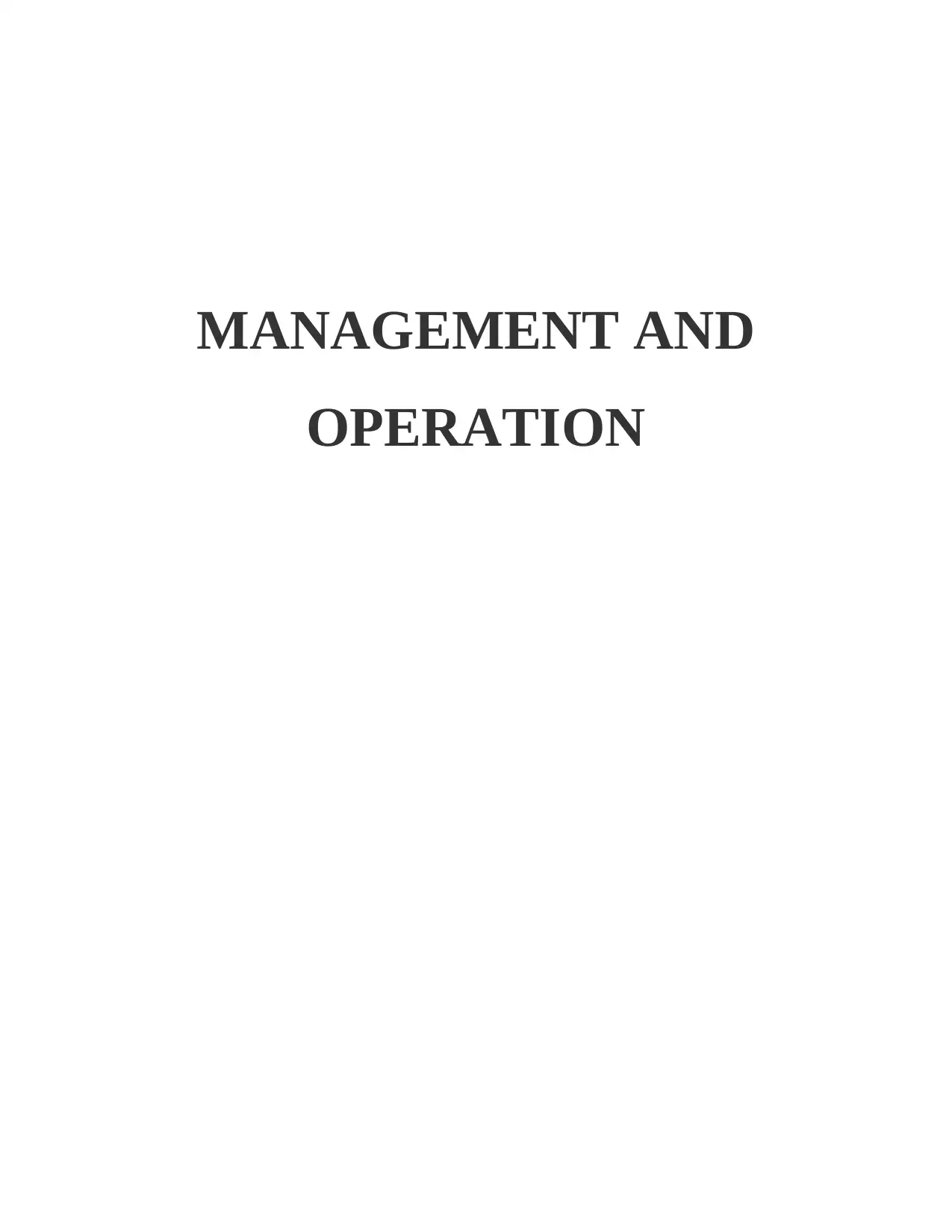
MANAGEMENT AND
OPERATION
OPERATION
Paraphrase This Document
Need a fresh take? Get an instant paraphrase of this document with our AI Paraphraser
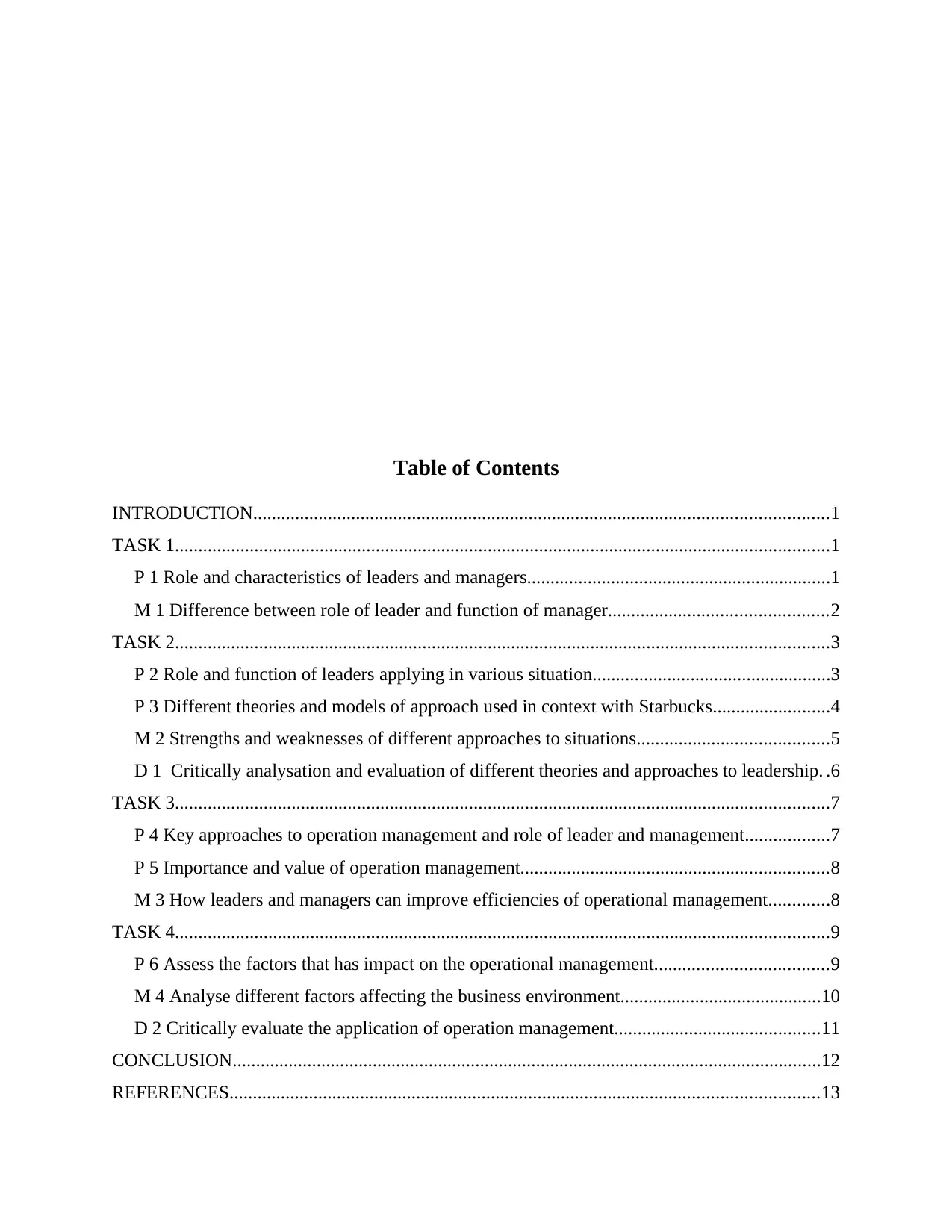
Table of Contents
INTRODUCTION...........................................................................................................................1
TASK 1............................................................................................................................................1
P 1 Role and characteristics of leaders and managers.................................................................1
M 1 Difference between role of leader and function of manager...............................................2
TASK 2............................................................................................................................................3
P 2 Role and function of leaders applying in various situation...................................................3
P 3 Different theories and models of approach used in context with Starbucks.........................4
M 2 Strengths and weaknesses of different approaches to situations.........................................5
D 1 Critically analysation and evaluation of different theories and approaches to leadership. .6
TASK 3............................................................................................................................................7
P 4 Key approaches to operation management and role of leader and management..................7
P 5 Importance and value of operation management..................................................................8
M 3 How leaders and managers can improve efficiencies of operational management.............8
TASK 4............................................................................................................................................9
P 6 Assess the factors that has impact on the operational management.....................................9
M 4 Analyse different factors affecting the business environment...........................................10
D 2 Critically evaluate the application of operation management............................................11
CONCLUSION..............................................................................................................................12
REFERENCES..............................................................................................................................13
INTRODUCTION...........................................................................................................................1
TASK 1............................................................................................................................................1
P 1 Role and characteristics of leaders and managers.................................................................1
M 1 Difference between role of leader and function of manager...............................................2
TASK 2............................................................................................................................................3
P 2 Role and function of leaders applying in various situation...................................................3
P 3 Different theories and models of approach used in context with Starbucks.........................4
M 2 Strengths and weaknesses of different approaches to situations.........................................5
D 1 Critically analysation and evaluation of different theories and approaches to leadership. .6
TASK 3............................................................................................................................................7
P 4 Key approaches to operation management and role of leader and management..................7
P 5 Importance and value of operation management..................................................................8
M 3 How leaders and managers can improve efficiencies of operational management.............8
TASK 4............................................................................................................................................9
P 6 Assess the factors that has impact on the operational management.....................................9
M 4 Analyse different factors affecting the business environment...........................................10
D 2 Critically evaluate the application of operation management............................................11
CONCLUSION..............................................................................................................................12
REFERENCES..............................................................................................................................13

⊘ This is a preview!⊘
Do you want full access?
Subscribe today to unlock all pages.

Trusted by 1+ million students worldwide
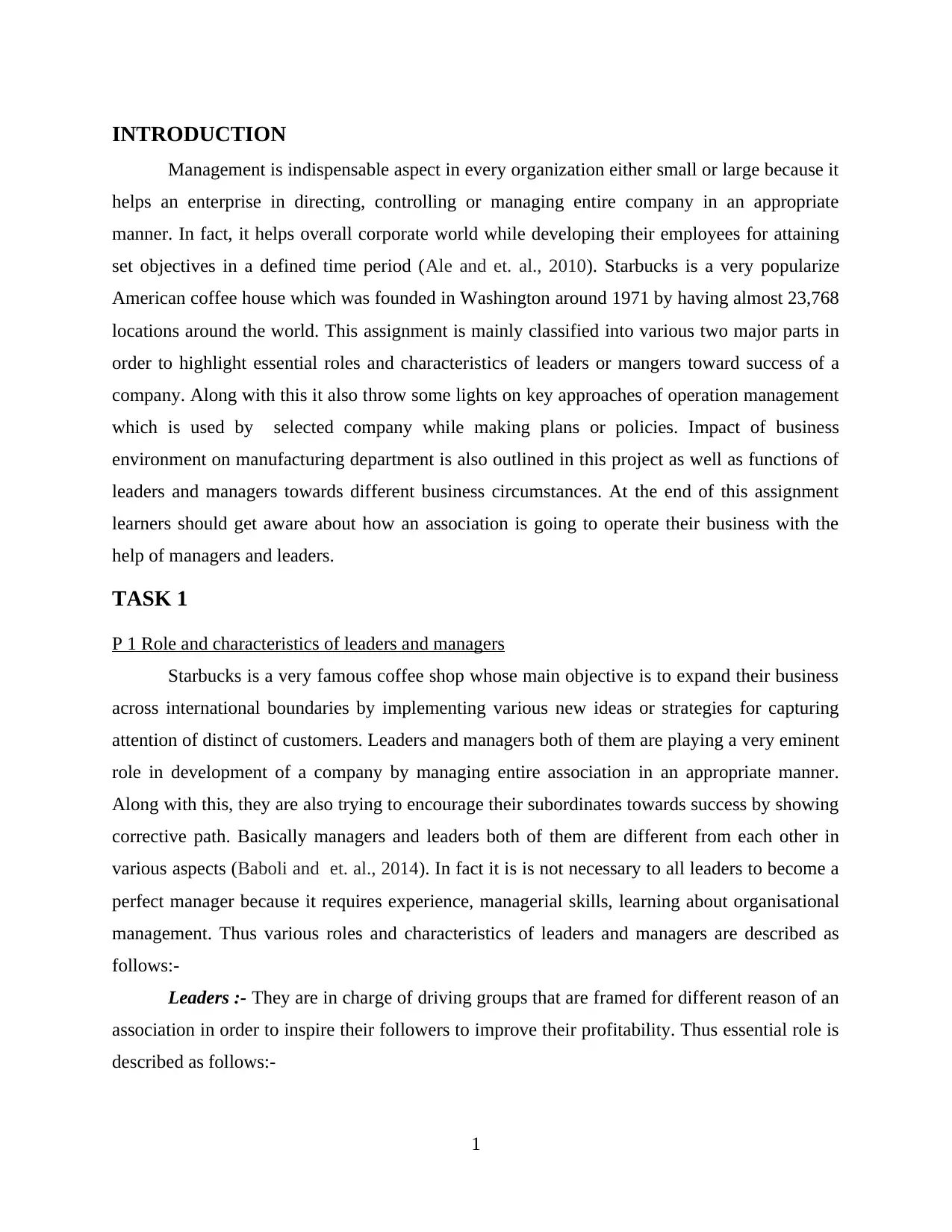
INTRODUCTION
Management is indispensable aspect in every organization either small or large because it
helps an enterprise in directing, controlling or managing entire company in an appropriate
manner. In fact, it helps overall corporate world while developing their employees for attaining
set objectives in a defined time period (Ale and et. al., 2010). Starbucks is a very popularize
American coffee house which was founded in Washington around 1971 by having almost 23,768
locations around the world. This assignment is mainly classified into various two major parts in
order to highlight essential roles and characteristics of leaders or mangers toward success of a
company. Along with this it also throw some lights on key approaches of operation management
which is used by selected company while making plans or policies. Impact of business
environment on manufacturing department is also outlined in this project as well as functions of
leaders and managers towards different business circumstances. At the end of this assignment
learners should get aware about how an association is going to operate their business with the
help of managers and leaders.
TASK 1
P 1 Role and characteristics of leaders and managers
Starbucks is a very famous coffee shop whose main objective is to expand their business
across international boundaries by implementing various new ideas or strategies for capturing
attention of distinct of customers. Leaders and managers both of them are playing a very eminent
role in development of a company by managing entire association in an appropriate manner.
Along with this, they are also trying to encourage their subordinates towards success by showing
corrective path. Basically managers and leaders both of them are different from each other in
various aspects (Baboli and et. al., 2014). In fact it is is not necessary to all leaders to become a
perfect manager because it requires experience, managerial skills, learning about organisational
management. Thus various roles and characteristics of leaders and managers are described as
follows:-
Leaders :- They are in charge of driving groups that are framed for different reason of an
association in order to inspire their followers to improve their profitability. Thus essential role is
described as follows:-
1
Management is indispensable aspect in every organization either small or large because it
helps an enterprise in directing, controlling or managing entire company in an appropriate
manner. In fact, it helps overall corporate world while developing their employees for attaining
set objectives in a defined time period (Ale and et. al., 2010). Starbucks is a very popularize
American coffee house which was founded in Washington around 1971 by having almost 23,768
locations around the world. This assignment is mainly classified into various two major parts in
order to highlight essential roles and characteristics of leaders or mangers toward success of a
company. Along with this it also throw some lights on key approaches of operation management
which is used by selected company while making plans or policies. Impact of business
environment on manufacturing department is also outlined in this project as well as functions of
leaders and managers towards different business circumstances. At the end of this assignment
learners should get aware about how an association is going to operate their business with the
help of managers and leaders.
TASK 1
P 1 Role and characteristics of leaders and managers
Starbucks is a very famous coffee shop whose main objective is to expand their business
across international boundaries by implementing various new ideas or strategies for capturing
attention of distinct of customers. Leaders and managers both of them are playing a very eminent
role in development of a company by managing entire association in an appropriate manner.
Along with this, they are also trying to encourage their subordinates towards success by showing
corrective path. Basically managers and leaders both of them are different from each other in
various aspects (Baboli and et. al., 2014). In fact it is is not necessary to all leaders to become a
perfect manager because it requires experience, managerial skills, learning about organisational
management. Thus various roles and characteristics of leaders and managers are described as
follows:-
Leaders :- They are in charge of driving groups that are framed for different reason of an
association in order to inspire their followers to improve their profitability. Thus essential role is
described as follows:-
1
Paraphrase This Document
Need a fresh take? Get an instant paraphrase of this document with our AI Paraphraser
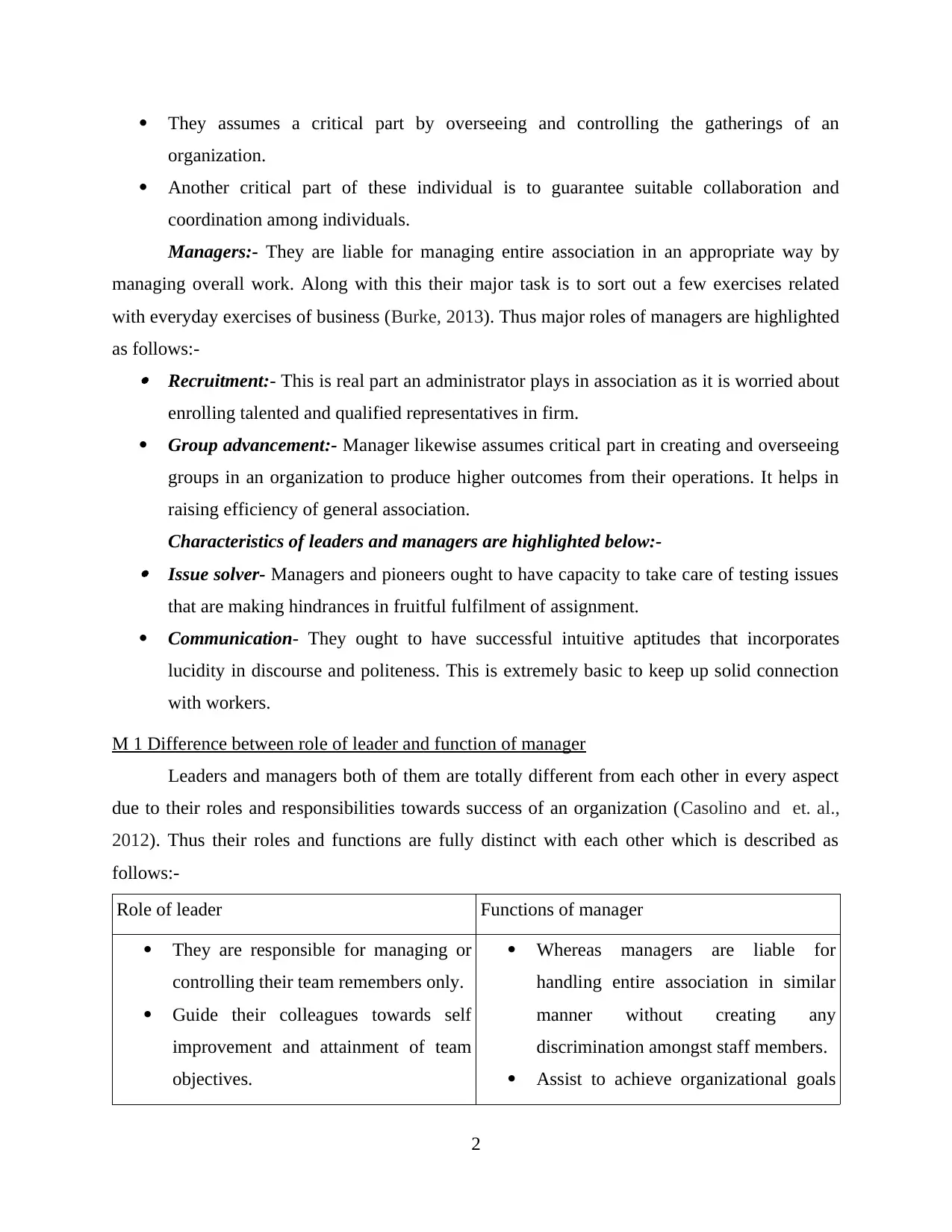
They assumes a critical part by overseeing and controlling the gatherings of an
organization.
Another critical part of these individual is to guarantee suitable collaboration and
coordination among individuals.
Managers:- They are liable for managing entire association in an appropriate way by
managing overall work. Along with this their major task is to sort out a few exercises related
with everyday exercises of business (Burke, 2013). Thus major roles of managers are highlighted
as follows:- Recruitment:- This is real part an administrator plays in association as it is worried about
enrolling talented and qualified representatives in firm.
Group advancement:- Manager likewise assumes critical part in creating and overseeing
groups in an organization to produce higher outcomes from their operations. It helps in
raising efficiency of general association.
Characteristics of leaders and managers are highlighted below:- Issue solver- Managers and pioneers ought to have capacity to take care of testing issues
that are making hindrances in fruitful fulfilment of assignment.
Communication- They ought to have successful intuitive aptitudes that incorporates
lucidity in discourse and politeness. This is extremely basic to keep up solid connection
with workers.
M 1 Difference between role of leader and function of manager
Leaders and managers both of them are totally different from each other in every aspect
due to their roles and responsibilities towards success of an organization (Casolino and et. al.,
2012). Thus their roles and functions are fully distinct with each other which is described as
follows:-
Role of leader Functions of manager
They are responsible for managing or
controlling their team remembers only.
Guide their colleagues towards self
improvement and attainment of team
objectives.
Whereas managers are liable for
handling entire association in similar
manner without creating any
discrimination amongst staff members.
Assist to achieve organizational goals
2
organization.
Another critical part of these individual is to guarantee suitable collaboration and
coordination among individuals.
Managers:- They are liable for managing entire association in an appropriate way by
managing overall work. Along with this their major task is to sort out a few exercises related
with everyday exercises of business (Burke, 2013). Thus major roles of managers are highlighted
as follows:- Recruitment:- This is real part an administrator plays in association as it is worried about
enrolling talented and qualified representatives in firm.
Group advancement:- Manager likewise assumes critical part in creating and overseeing
groups in an organization to produce higher outcomes from their operations. It helps in
raising efficiency of general association.
Characteristics of leaders and managers are highlighted below:- Issue solver- Managers and pioneers ought to have capacity to take care of testing issues
that are making hindrances in fruitful fulfilment of assignment.
Communication- They ought to have successful intuitive aptitudes that incorporates
lucidity in discourse and politeness. This is extremely basic to keep up solid connection
with workers.
M 1 Difference between role of leader and function of manager
Leaders and managers both of them are totally different from each other in every aspect
due to their roles and responsibilities towards success of an organization (Casolino and et. al.,
2012). Thus their roles and functions are fully distinct with each other which is described as
follows:-
Role of leader Functions of manager
They are responsible for managing or
controlling their team remembers only.
Guide their colleagues towards self
improvement and attainment of team
objectives.
Whereas managers are liable for
handling entire association in similar
manner without creating any
discrimination amongst staff members.
Assist to achieve organizational goals
2
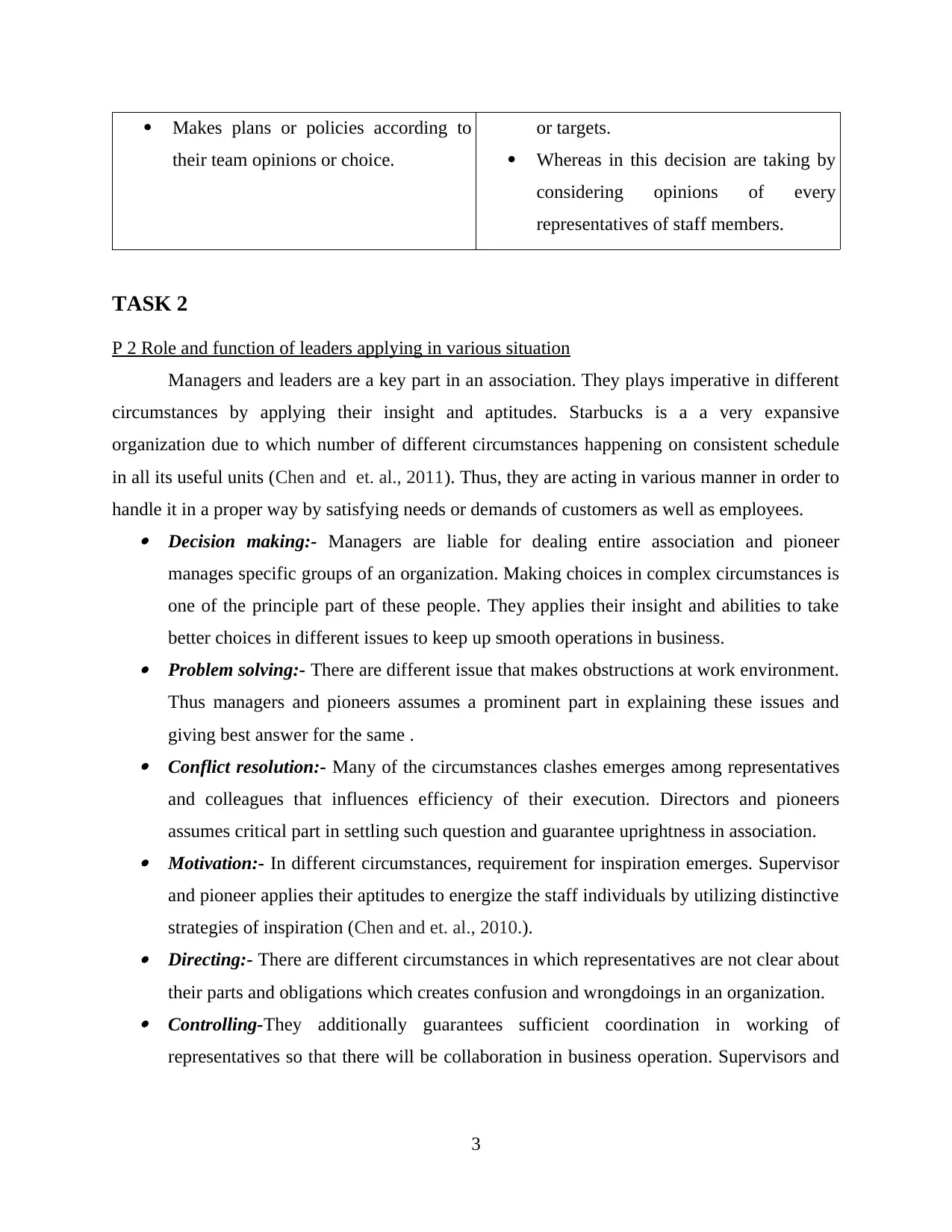
Makes plans or policies according to
their team opinions or choice.
or targets.
Whereas in this decision are taking by
considering opinions of every
representatives of staff members.
TASK 2
P 2 Role and function of leaders applying in various situation
Managers and leaders are a key part in an association. They plays imperative in different
circumstances by applying their insight and aptitudes. Starbucks is a a very expansive
organization due to which number of different circumstances happening on consistent schedule
in all its useful units (Chen and et. al., 2011). Thus, they are acting in various manner in order to
handle it in a proper way by satisfying needs or demands of customers as well as employees. Decision making:- Managers are liable for dealing entire association and pioneer
manages specific groups of an organization. Making choices in complex circumstances is
one of the principle part of these people. They applies their insight and abilities to take
better choices in different issues to keep up smooth operations in business. Problem solving:- There are different issue that makes obstructions at work environment.
Thus managers and pioneers assumes a prominent part in explaining these issues and
giving best answer for the same . Conflict resolution:- Many of the circumstances clashes emerges among representatives
and colleagues that influences efficiency of their execution. Directors and pioneers
assumes critical part in settling such question and guarantee uprightness in association. Motivation:- In different circumstances, requirement for inspiration emerges. Supervisor
and pioneer applies their aptitudes to energize the staff individuals by utilizing distinctive
strategies of inspiration (Chen and et. al., 2010.). Directing:- There are different circumstances in which representatives are not clear about
their parts and obligations which creates confusion and wrongdoings in an organization. Controlling-They additionally guarantees sufficient coordination in working of
representatives so that there will be collaboration in business operation. Supervisors and
3
their team opinions or choice.
or targets.
Whereas in this decision are taking by
considering opinions of every
representatives of staff members.
TASK 2
P 2 Role and function of leaders applying in various situation
Managers and leaders are a key part in an association. They plays imperative in different
circumstances by applying their insight and aptitudes. Starbucks is a a very expansive
organization due to which number of different circumstances happening on consistent schedule
in all its useful units (Chen and et. al., 2011). Thus, they are acting in various manner in order to
handle it in a proper way by satisfying needs or demands of customers as well as employees. Decision making:- Managers are liable for dealing entire association and pioneer
manages specific groups of an organization. Making choices in complex circumstances is
one of the principle part of these people. They applies their insight and abilities to take
better choices in different issues to keep up smooth operations in business. Problem solving:- There are different issue that makes obstructions at work environment.
Thus managers and pioneers assumes a prominent part in explaining these issues and
giving best answer for the same . Conflict resolution:- Many of the circumstances clashes emerges among representatives
and colleagues that influences efficiency of their execution. Directors and pioneers
assumes critical part in settling such question and guarantee uprightness in association. Motivation:- In different circumstances, requirement for inspiration emerges. Supervisor
and pioneer applies their aptitudes to energize the staff individuals by utilizing distinctive
strategies of inspiration (Chen and et. al., 2010.). Directing:- There are different circumstances in which representatives are not clear about
their parts and obligations which creates confusion and wrongdoings in an organization. Controlling-They additionally guarantees sufficient coordination in working of
representatives so that there will be collaboration in business operation. Supervisors and
3
⊘ This is a preview!⊘
Do you want full access?
Subscribe today to unlock all pages.

Trusted by 1+ million students worldwide
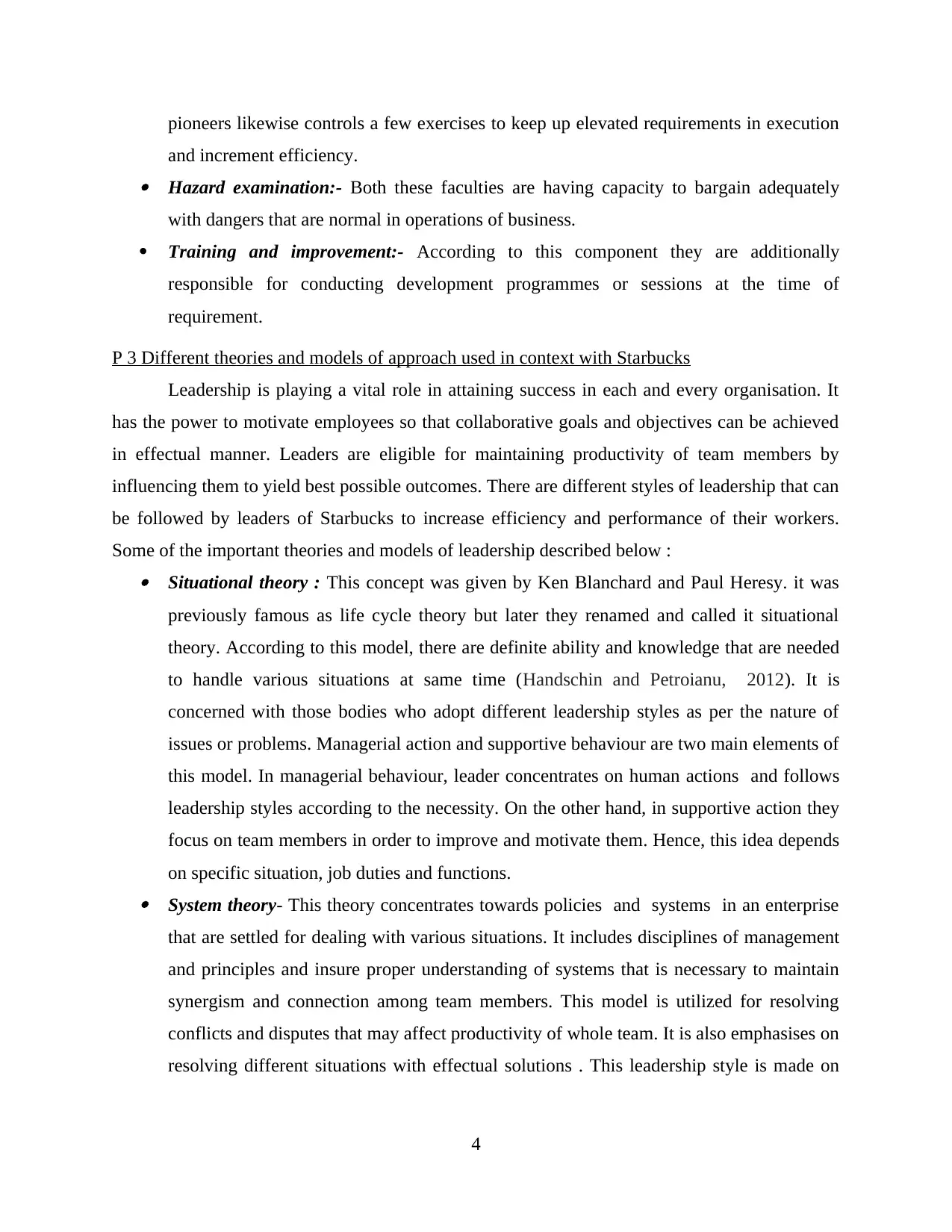
pioneers likewise controls a few exercises to keep up elevated requirements in execution
and increment efficiency. Hazard examination:- Both these faculties are having capacity to bargain adequately
with dangers that are normal in operations of business.
Training and improvement:- According to this component they are additionally
responsible for conducting development programmes or sessions at the time of
requirement.
P 3 Different theories and models of approach used in context with Starbucks
Leadership is playing a vital role in attaining success in each and every organisation. It
has the power to motivate employees so that collaborative goals and objectives can be achieved
in effectual manner. Leaders are eligible for maintaining productivity of team members by
influencing them to yield best possible outcomes. There are different styles of leadership that can
be followed by leaders of Starbucks to increase efficiency and performance of their workers.
Some of the important theories and models of leadership described below : Situational theory : This concept was given by Ken Blanchard and Paul Heresy. it was
previously famous as life cycle theory but later they renamed and called it situational
theory. According to this model, there are definite ability and knowledge that are needed
to handle various situations at same time (Handschin and Petroianu, 2012). It is
concerned with those bodies who adopt different leadership styles as per the nature of
issues or problems. Managerial action and supportive behaviour are two main elements of
this model. In managerial behaviour, leader concentrates on human actions and follows
leadership styles according to the necessity. On the other hand, in supportive action they
focus on team members in order to improve and motivate them. Hence, this idea depends
on specific situation, job duties and functions. System theory- This theory concentrates towards policies and systems in an enterprise
that are settled for dealing with various situations. It includes disciplines of management
and principles and insure proper understanding of systems that is necessary to maintain
synergism and connection among team members. This model is utilized for resolving
conflicts and disputes that may affect productivity of whole team. It is also emphasises on
resolving different situations with effectual solutions . This leadership style is made on
4
and increment efficiency. Hazard examination:- Both these faculties are having capacity to bargain adequately
with dangers that are normal in operations of business.
Training and improvement:- According to this component they are additionally
responsible for conducting development programmes or sessions at the time of
requirement.
P 3 Different theories and models of approach used in context with Starbucks
Leadership is playing a vital role in attaining success in each and every organisation. It
has the power to motivate employees so that collaborative goals and objectives can be achieved
in effectual manner. Leaders are eligible for maintaining productivity of team members by
influencing them to yield best possible outcomes. There are different styles of leadership that can
be followed by leaders of Starbucks to increase efficiency and performance of their workers.
Some of the important theories and models of leadership described below : Situational theory : This concept was given by Ken Blanchard and Paul Heresy. it was
previously famous as life cycle theory but later they renamed and called it situational
theory. According to this model, there are definite ability and knowledge that are needed
to handle various situations at same time (Handschin and Petroianu, 2012). It is
concerned with those bodies who adopt different leadership styles as per the nature of
issues or problems. Managerial action and supportive behaviour are two main elements of
this model. In managerial behaviour, leader concentrates on human actions and follows
leadership styles according to the necessity. On the other hand, in supportive action they
focus on team members in order to improve and motivate them. Hence, this idea depends
on specific situation, job duties and functions. System theory- This theory concentrates towards policies and systems in an enterprise
that are settled for dealing with various situations. It includes disciplines of management
and principles and insure proper understanding of systems that is necessary to maintain
synergism and connection among team members. This model is utilized for resolving
conflicts and disputes that may affect productivity of whole team. It is also emphasises on
resolving different situations with effectual solutions . This leadership style is made on
4
Paraphrase This Document
Need a fresh take? Get an instant paraphrase of this document with our AI Paraphraser
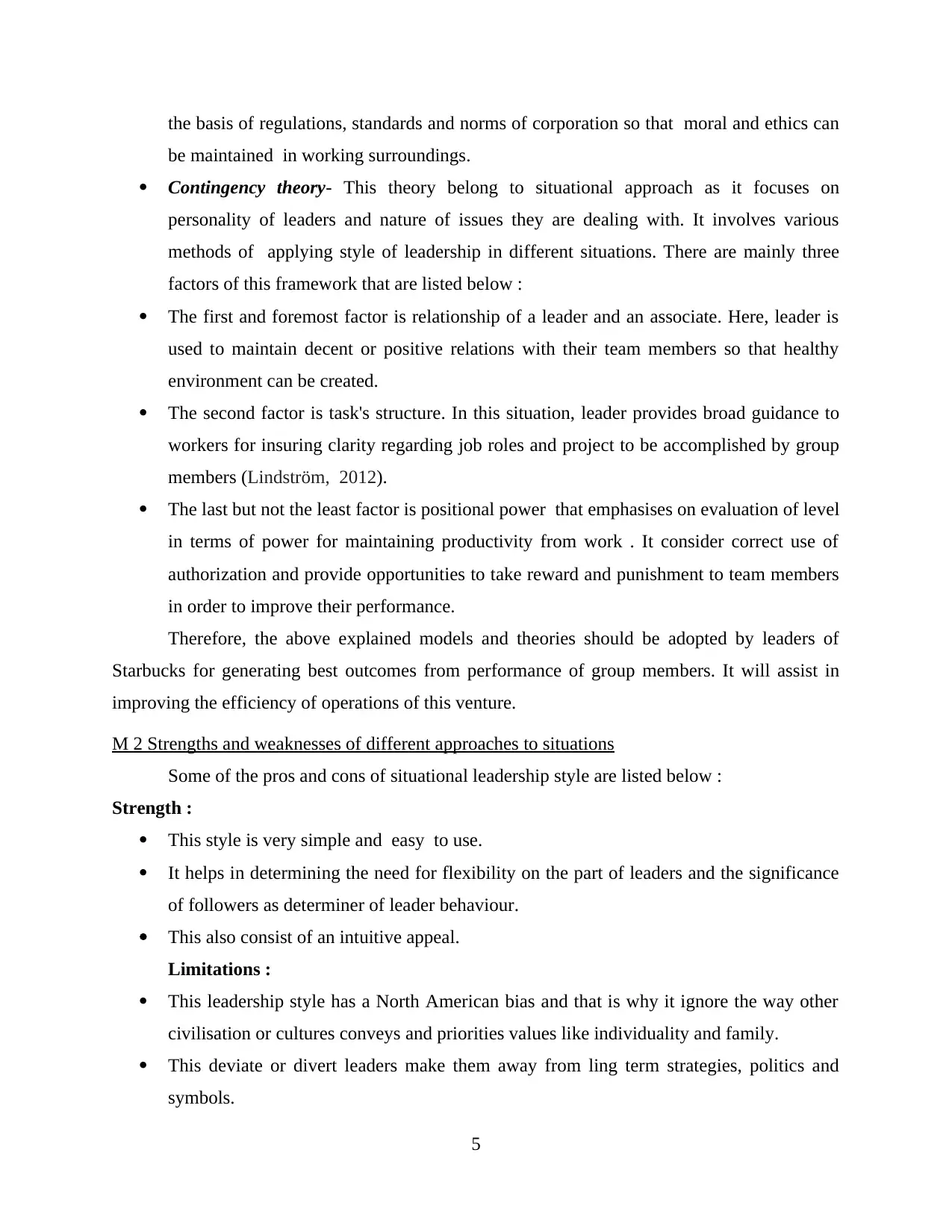
the basis of regulations, standards and norms of corporation so that moral and ethics can
be maintained in working surroundings.
Contingency theory- This theory belong to situational approach as it focuses on
personality of leaders and nature of issues they are dealing with. It involves various
methods of applying style of leadership in different situations. There are mainly three
factors of this framework that are listed below :
The first and foremost factor is relationship of a leader and an associate. Here, leader is
used to maintain decent or positive relations with their team members so that healthy
environment can be created.
The second factor is task's structure. In this situation, leader provides broad guidance to
workers for insuring clarity regarding job roles and project to be accomplished by group
members (Lindström, 2012).
The last but not the least factor is positional power that emphasises on evaluation of level
in terms of power for maintaining productivity from work . It consider correct use of
authorization and provide opportunities to take reward and punishment to team members
in order to improve their performance.
Therefore, the above explained models and theories should be adopted by leaders of
Starbucks for generating best outcomes from performance of group members. It will assist in
improving the efficiency of operations of this venture.
M 2 Strengths and weaknesses of different approaches to situations
Some of the pros and cons of situational leadership style are listed below :
Strength :
This style is very simple and easy to use.
It helps in determining the need for flexibility on the part of leaders and the significance
of followers as determiner of leader behaviour.
This also consist of an intuitive appeal.
Limitations :
This leadership style has a North American bias and that is why it ignore the way other
civilisation or cultures conveys and priorities values like individuality and family.
This deviate or divert leaders make them away from ling term strategies, politics and
symbols.
5
be maintained in working surroundings.
Contingency theory- This theory belong to situational approach as it focuses on
personality of leaders and nature of issues they are dealing with. It involves various
methods of applying style of leadership in different situations. There are mainly three
factors of this framework that are listed below :
The first and foremost factor is relationship of a leader and an associate. Here, leader is
used to maintain decent or positive relations with their team members so that healthy
environment can be created.
The second factor is task's structure. In this situation, leader provides broad guidance to
workers for insuring clarity regarding job roles and project to be accomplished by group
members (Lindström, 2012).
The last but not the least factor is positional power that emphasises on evaluation of level
in terms of power for maintaining productivity from work . It consider correct use of
authorization and provide opportunities to take reward and punishment to team members
in order to improve their performance.
Therefore, the above explained models and theories should be adopted by leaders of
Starbucks for generating best outcomes from performance of group members. It will assist in
improving the efficiency of operations of this venture.
M 2 Strengths and weaknesses of different approaches to situations
Some of the pros and cons of situational leadership style are listed below :
Strength :
This style is very simple and easy to use.
It helps in determining the need for flexibility on the part of leaders and the significance
of followers as determiner of leader behaviour.
This also consist of an intuitive appeal.
Limitations :
This leadership style has a North American bias and that is why it ignore the way other
civilisation or cultures conveys and priorities values like individuality and family.
This deviate or divert leaders make them away from ling term strategies, politics and
symbols.
5
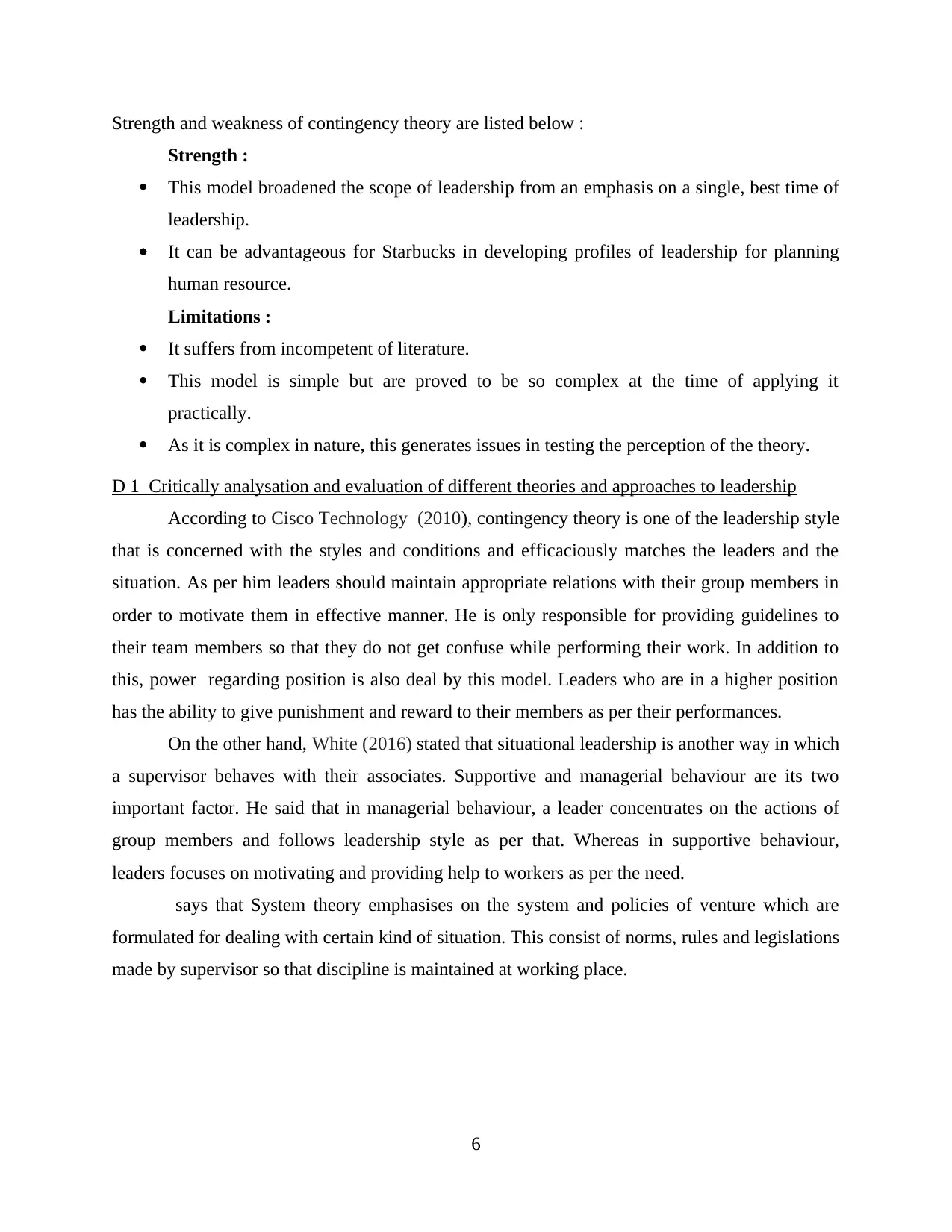
Strength and weakness of contingency theory are listed below :
Strength :
This model broadened the scope of leadership from an emphasis on a single, best time of
leadership.
It can be advantageous for Starbucks in developing profiles of leadership for planning
human resource.
Limitations :
It suffers from incompetent of literature.
This model is simple but are proved to be so complex at the time of applying it
practically.
As it is complex in nature, this generates issues in testing the perception of the theory.
D 1 Critically analysation and evaluation of different theories and approaches to leadership
According to Cisco Technology (2010), contingency theory is one of the leadership style
that is concerned with the styles and conditions and efficaciously matches the leaders and the
situation. As per him leaders should maintain appropriate relations with their group members in
order to motivate them in effective manner. He is only responsible for providing guidelines to
their team members so that they do not get confuse while performing their work. In addition to
this, power regarding position is also deal by this model. Leaders who are in a higher position
has the ability to give punishment and reward to their members as per their performances.
On the other hand, White (2016) stated that situational leadership is another way in which
a supervisor behaves with their associates. Supportive and managerial behaviour are its two
important factor. He said that in managerial behaviour, a leader concentrates on the actions of
group members and follows leadership style as per that. Whereas in supportive behaviour,
leaders focuses on motivating and providing help to workers as per the need.
says that System theory emphasises on the system and policies of venture which are
formulated for dealing with certain kind of situation. This consist of norms, rules and legislations
made by supervisor so that discipline is maintained at working place.
6
Strength :
This model broadened the scope of leadership from an emphasis on a single, best time of
leadership.
It can be advantageous for Starbucks in developing profiles of leadership for planning
human resource.
Limitations :
It suffers from incompetent of literature.
This model is simple but are proved to be so complex at the time of applying it
practically.
As it is complex in nature, this generates issues in testing the perception of the theory.
D 1 Critically analysation and evaluation of different theories and approaches to leadership
According to Cisco Technology (2010), contingency theory is one of the leadership style
that is concerned with the styles and conditions and efficaciously matches the leaders and the
situation. As per him leaders should maintain appropriate relations with their group members in
order to motivate them in effective manner. He is only responsible for providing guidelines to
their team members so that they do not get confuse while performing their work. In addition to
this, power regarding position is also deal by this model. Leaders who are in a higher position
has the ability to give punishment and reward to their members as per their performances.
On the other hand, White (2016) stated that situational leadership is another way in which
a supervisor behaves with their associates. Supportive and managerial behaviour are its two
important factor. He said that in managerial behaviour, a leader concentrates on the actions of
group members and follows leadership style as per that. Whereas in supportive behaviour,
leaders focuses on motivating and providing help to workers as per the need.
says that System theory emphasises on the system and policies of venture which are
formulated for dealing with certain kind of situation. This consist of norms, rules and legislations
made by supervisor so that discipline is maintained at working place.
6
⊘ This is a preview!⊘
Do you want full access?
Subscribe today to unlock all pages.

Trusted by 1+ million students worldwide
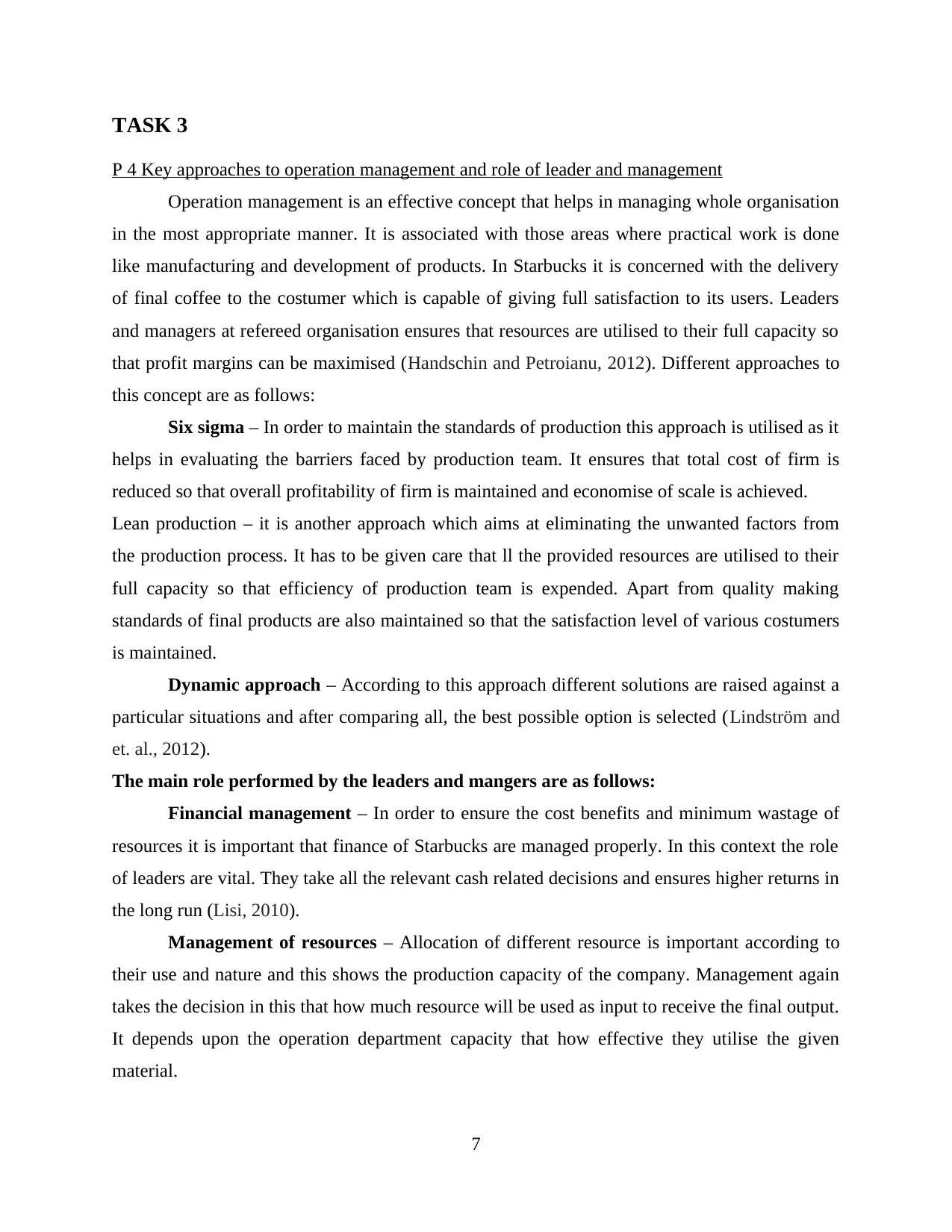
TASK 3
P 4 Key approaches to operation management and role of leader and management
Operation management is an effective concept that helps in managing whole organisation
in the most appropriate manner. It is associated with those areas where practical work is done
like manufacturing and development of products. In Starbucks it is concerned with the delivery
of final coffee to the costumer which is capable of giving full satisfaction to its users. Leaders
and managers at refereed organisation ensures that resources are utilised to their full capacity so
that profit margins can be maximised (Handschin and Petroianu, 2012). Different approaches to
this concept are as follows:
Six sigma – In order to maintain the standards of production this approach is utilised as it
helps in evaluating the barriers faced by production team. It ensures that total cost of firm is
reduced so that overall profitability of firm is maintained and economise of scale is achieved.
Lean production – it is another approach which aims at eliminating the unwanted factors from
the production process. It has to be given care that ll the provided resources are utilised to their
full capacity so that efficiency of production team is expended. Apart from quality making
standards of final products are also maintained so that the satisfaction level of various costumers
is maintained.
Dynamic approach – According to this approach different solutions are raised against a
particular situations and after comparing all, the best possible option is selected (Lindström and
et. al., 2012).
The main role performed by the leaders and mangers are as follows:
Financial management – In order to ensure the cost benefits and minimum wastage of
resources it is important that finance of Starbucks are managed properly. In this context the role
of leaders are vital. They take all the relevant cash related decisions and ensures higher returns in
the long run (Lisi, 2010).
Management of resources – Allocation of different resource is important according to
their use and nature and this shows the production capacity of the company. Management again
takes the decision in this that how much resource will be used as input to receive the final output.
It depends upon the operation department capacity that how effective they utilise the given
material.
7
P 4 Key approaches to operation management and role of leader and management
Operation management is an effective concept that helps in managing whole organisation
in the most appropriate manner. It is associated with those areas where practical work is done
like manufacturing and development of products. In Starbucks it is concerned with the delivery
of final coffee to the costumer which is capable of giving full satisfaction to its users. Leaders
and managers at refereed organisation ensures that resources are utilised to their full capacity so
that profit margins can be maximised (Handschin and Petroianu, 2012). Different approaches to
this concept are as follows:
Six sigma – In order to maintain the standards of production this approach is utilised as it
helps in evaluating the barriers faced by production team. It ensures that total cost of firm is
reduced so that overall profitability of firm is maintained and economise of scale is achieved.
Lean production – it is another approach which aims at eliminating the unwanted factors from
the production process. It has to be given care that ll the provided resources are utilised to their
full capacity so that efficiency of production team is expended. Apart from quality making
standards of final products are also maintained so that the satisfaction level of various costumers
is maintained.
Dynamic approach – According to this approach different solutions are raised against a
particular situations and after comparing all, the best possible option is selected (Lindström and
et. al., 2012).
The main role performed by the leaders and mangers are as follows:
Financial management – In order to ensure the cost benefits and minimum wastage of
resources it is important that finance of Starbucks are managed properly. In this context the role
of leaders are vital. They take all the relevant cash related decisions and ensures higher returns in
the long run (Lisi, 2010).
Management of resources – Allocation of different resource is important according to
their use and nature and this shows the production capacity of the company. Management again
takes the decision in this that how much resource will be used as input to receive the final output.
It depends upon the operation department capacity that how effective they utilise the given
material.
7
Paraphrase This Document
Need a fresh take? Get an instant paraphrase of this document with our AI Paraphraser
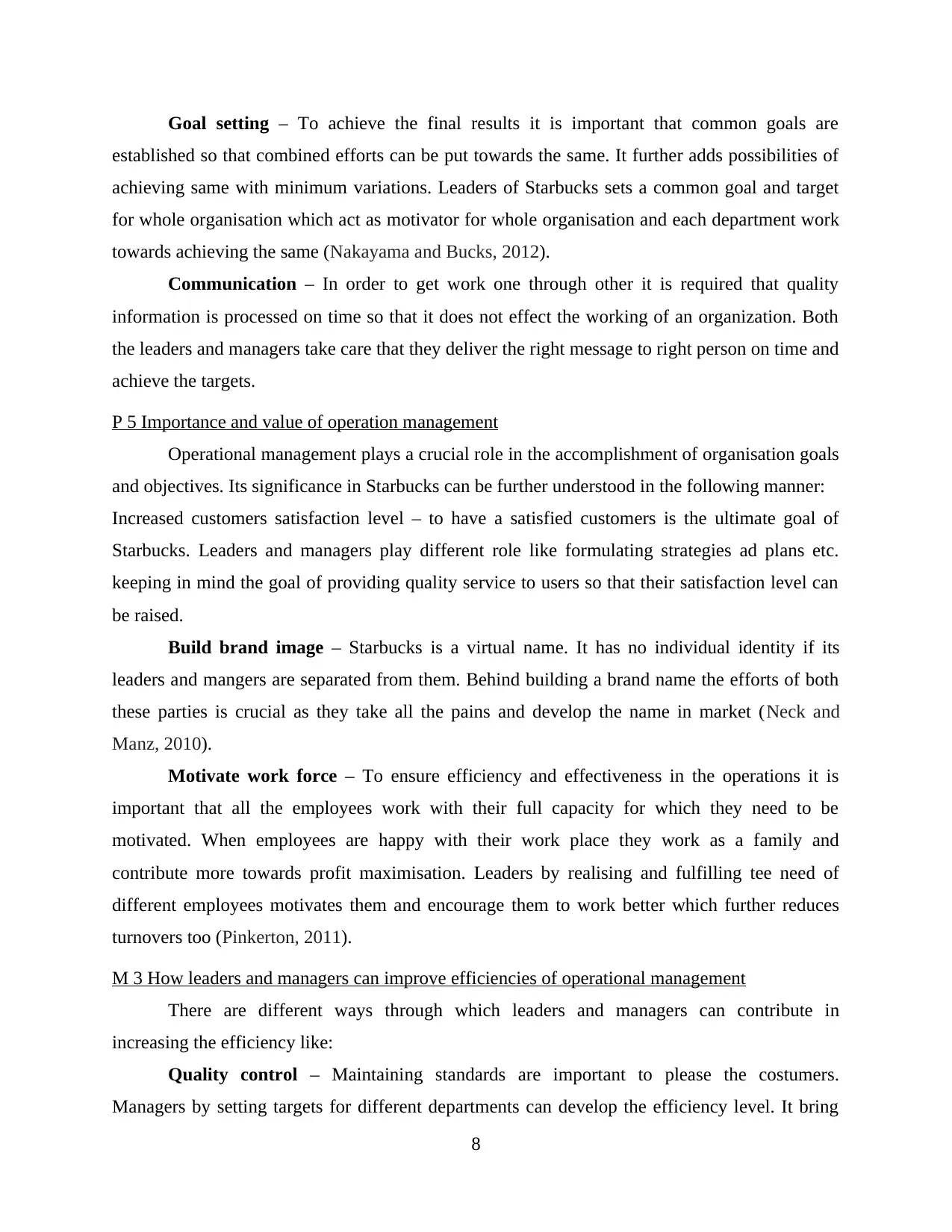
Goal setting – To achieve the final results it is important that common goals are
established so that combined efforts can be put towards the same. It further adds possibilities of
achieving same with minimum variations. Leaders of Starbucks sets a common goal and target
for whole organisation which act as motivator for whole organisation and each department work
towards achieving the same (Nakayama and Bucks, 2012).
Communication – In order to get work one through other it is required that quality
information is processed on time so that it does not effect the working of an organization. Both
the leaders and managers take care that they deliver the right message to right person on time and
achieve the targets.
P 5 Importance and value of operation management
Operational management plays a crucial role in the accomplishment of organisation goals
and objectives. Its significance in Starbucks can be further understood in the following manner:
Increased customers satisfaction level – to have a satisfied customers is the ultimate goal of
Starbucks. Leaders and managers play different role like formulating strategies ad plans etc.
keeping in mind the goal of providing quality service to users so that their satisfaction level can
be raised.
Build brand image – Starbucks is a virtual name. It has no individual identity if its
leaders and mangers are separated from them. Behind building a brand name the efforts of both
these parties is crucial as they take all the pains and develop the name in market (Neck and
Manz, 2010).
Motivate work force – To ensure efficiency and effectiveness in the operations it is
important that all the employees work with their full capacity for which they need to be
motivated. When employees are happy with their work place they work as a family and
contribute more towards profit maximisation. Leaders by realising and fulfilling tee need of
different employees motivates them and encourage them to work better which further reduces
turnovers too (Pinkerton, 2011).
M 3 How leaders and managers can improve efficiencies of operational management
There are different ways through which leaders and managers can contribute in
increasing the efficiency like:
Quality control – Maintaining standards are important to please the costumers.
Managers by setting targets for different departments can develop the efficiency level. It bring
8
established so that combined efforts can be put towards the same. It further adds possibilities of
achieving same with minimum variations. Leaders of Starbucks sets a common goal and target
for whole organisation which act as motivator for whole organisation and each department work
towards achieving the same (Nakayama and Bucks, 2012).
Communication – In order to get work one through other it is required that quality
information is processed on time so that it does not effect the working of an organization. Both
the leaders and managers take care that they deliver the right message to right person on time and
achieve the targets.
P 5 Importance and value of operation management
Operational management plays a crucial role in the accomplishment of organisation goals
and objectives. Its significance in Starbucks can be further understood in the following manner:
Increased customers satisfaction level – to have a satisfied customers is the ultimate goal of
Starbucks. Leaders and managers play different role like formulating strategies ad plans etc.
keeping in mind the goal of providing quality service to users so that their satisfaction level can
be raised.
Build brand image – Starbucks is a virtual name. It has no individual identity if its
leaders and mangers are separated from them. Behind building a brand name the efforts of both
these parties is crucial as they take all the pains and develop the name in market (Neck and
Manz, 2010).
Motivate work force – To ensure efficiency and effectiveness in the operations it is
important that all the employees work with their full capacity for which they need to be
motivated. When employees are happy with their work place they work as a family and
contribute more towards profit maximisation. Leaders by realising and fulfilling tee need of
different employees motivates them and encourage them to work better which further reduces
turnovers too (Pinkerton, 2011).
M 3 How leaders and managers can improve efficiencies of operational management
There are different ways through which leaders and managers can contribute in
increasing the efficiency like:
Quality control – Maintaining standards are important to please the costumers.
Managers by setting targets for different departments can develop the efficiency level. It bring
8
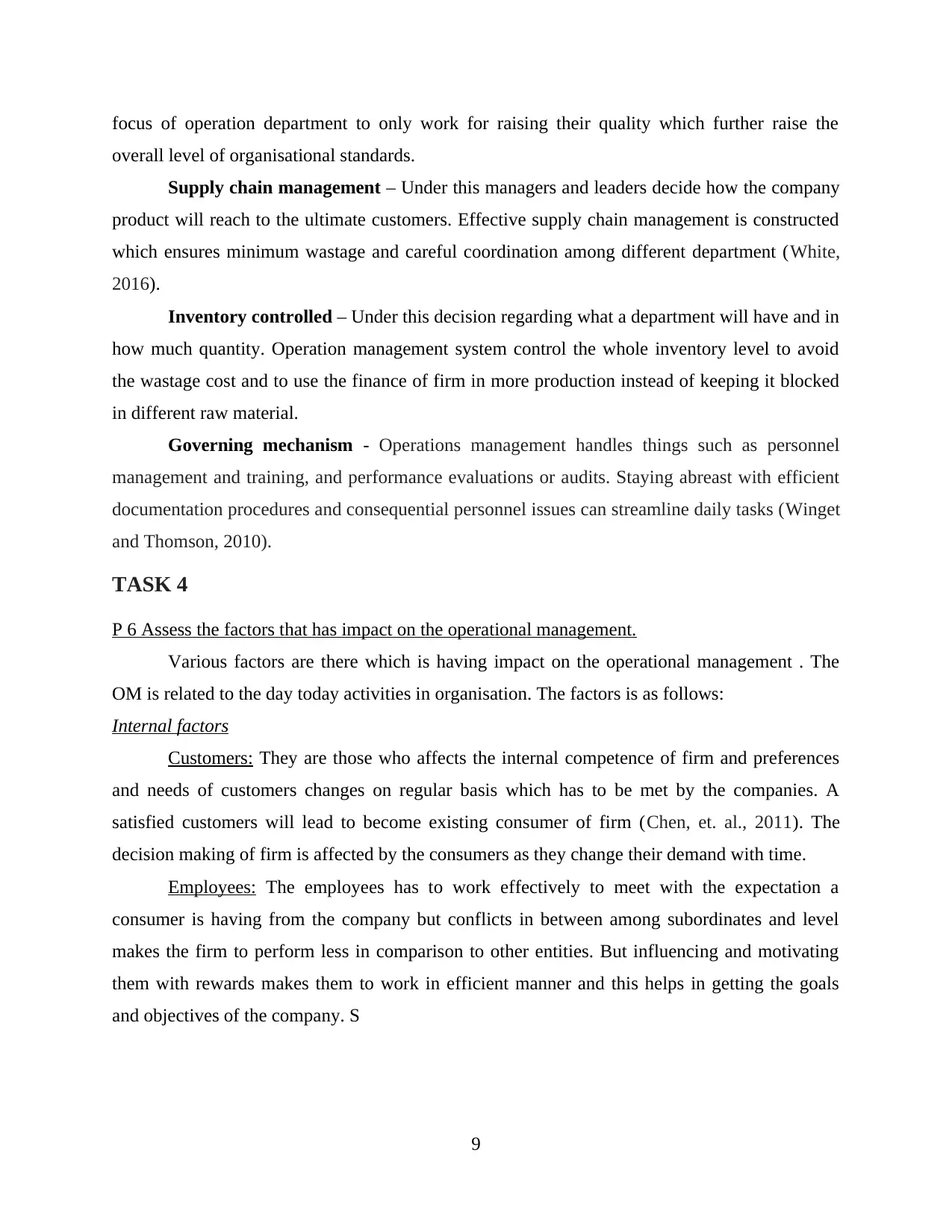
focus of operation department to only work for raising their quality which further raise the
overall level of organisational standards.
Supply chain management – Under this managers and leaders decide how the company
product will reach to the ultimate customers. Effective supply chain management is constructed
which ensures minimum wastage and careful coordination among different department (White,
2016).
Inventory controlled – Under this decision regarding what a department will have and in
how much quantity. Operation management system control the whole inventory level to avoid
the wastage cost and to use the finance of firm in more production instead of keeping it blocked
in different raw material.
Governing mechanism - Operations management handles things such as personnel
management and training, and performance evaluations or audits. Staying abreast with efficient
documentation procedures and consequential personnel issues can streamline daily tasks (Winget
and Thomson, 2010).
TASK 4
P 6 Assess the factors that has impact on the operational management.
Various factors are there which is having impact on the operational management . The
OM is related to the day today activities in organisation. The factors is as follows:
Internal factors
Customers: They are those who affects the internal competence of firm and preferences
and needs of customers changes on regular basis which has to be met by the companies. A
satisfied customers will lead to become existing consumer of firm (Chen, et. al., 2011). The
decision making of firm is affected by the consumers as they change their demand with time.
Employees: The employees has to work effectively to meet with the expectation a
consumer is having from the company but conflicts in between among subordinates and level
makes the firm to perform less in comparison to other entities. But influencing and motivating
them with rewards makes them to work in efficient manner and this helps in getting the goals
and objectives of the company. S
9
overall level of organisational standards.
Supply chain management – Under this managers and leaders decide how the company
product will reach to the ultimate customers. Effective supply chain management is constructed
which ensures minimum wastage and careful coordination among different department (White,
2016).
Inventory controlled – Under this decision regarding what a department will have and in
how much quantity. Operation management system control the whole inventory level to avoid
the wastage cost and to use the finance of firm in more production instead of keeping it blocked
in different raw material.
Governing mechanism - Operations management handles things such as personnel
management and training, and performance evaluations or audits. Staying abreast with efficient
documentation procedures and consequential personnel issues can streamline daily tasks (Winget
and Thomson, 2010).
TASK 4
P 6 Assess the factors that has impact on the operational management.
Various factors are there which is having impact on the operational management . The
OM is related to the day today activities in organisation. The factors is as follows:
Internal factors
Customers: They are those who affects the internal competence of firm and preferences
and needs of customers changes on regular basis which has to be met by the companies. A
satisfied customers will lead to become existing consumer of firm (Chen, et. al., 2011). The
decision making of firm is affected by the consumers as they change their demand with time.
Employees: The employees has to work effectively to meet with the expectation a
consumer is having from the company but conflicts in between among subordinates and level
makes the firm to perform less in comparison to other entities. But influencing and motivating
them with rewards makes them to work in efficient manner and this helps in getting the goals
and objectives of the company. S
9
⊘ This is a preview!⊘
Do you want full access?
Subscribe today to unlock all pages.

Trusted by 1+ million students worldwide
1 out of 19
Related Documents
Your All-in-One AI-Powered Toolkit for Academic Success.
+13062052269
info@desklib.com
Available 24*7 on WhatsApp / Email
![[object Object]](/_next/static/media/star-bottom.7253800d.svg)
Unlock your academic potential
Copyright © 2020–2025 A2Z Services. All Rights Reserved. Developed and managed by ZUCOL.





